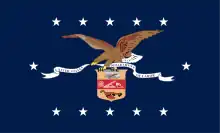Meyer Bernstein
Meyer Bernstein (1914–1985) was a 20th-Century American labor leader and educator who worked for the Steel Workers Organizing Committee (SWOC), the United Steel Workers of America (USWA), the U.S. Department of Labor, and the United Mine Workers of America (UMW).[1][2][3][4][5][6][7]
Background
Meyer Bernstein was born on March 30, 1914. His parents were Philip Bernstein and Sophie Rubin. He had a brother Jacob and two sisters, Lillian and Jennifer.[1][4]
In June 1932, he graduated from the Benjamin Franklin Junior-Senior High School in Rochester, New York, where he had managed the School Service Committee and run a newsstand during his senior year. In September 1932, he entered Cornell University on a competitive state scholarship and graduated with a degree in economics in 1936.[3][4][5]
Career
In 1936, Bernstein joined the SWOC. In 1937, he helped SWOC in the Little Steel strike, which he described later in his writings.[8] In 1938, Lee Pressman, general counsel of the Congress of Industrial Organizations CIO) as well as of SWOC (a CIO member) sent Bernstein into the field with A. W. Smith, a deputy general counsel to research hiring and firing patterns among "Little Steel." In 1939, he helped Pressman prepare CIO statements. He worked there until 1941 as a research assistant and national representative.[1][2][3][5][7][9][10]
During World War II, he served as U.S. Army Air Corps sergeant.[3][5][9]
In 1946, he joined the USWA, became Director of the International Affairs Department, and he worked until 1972.[1][3][5] In 1947, Bernstein wrote as an anti-communist against Pressman (amidst a rising tide led by Walter Reuther against pro-communists in the CIO); Pressman resigned shortly thereafter.[9] From 1953 through 1969, his efforts focused on the United Steel Workers International elections.[6][7]
In 1972, he joined the Labor Department to help observe a rerun of a 1969 United Mine Workers (UMW) election. "He was a union official in District 8 and District 16 of the United Steel Workers."[6] Later in 1972, he became director of the Public and International Affairs Department of the UMW just as Arnold Miller succeeded W. A. Boyle as the union's president. He stayed there into 1973.[1][2][7]
In 1975, he became executive secretary of the Labor Advisory Committee for Trade Negotiations at the Labor Department until retiring in 1982.[1][2][3][7]
Personal and death
At the end of his life, Bernstein lived in Brussels, Belgium.[1][2]
On December 10, 1985, he drowned near Miami Beach at the age of 71.[1][2]
Works
After 1945, Berstein's writings focused on Europe.[3]
See also
References
- "Meyer Bernstein Dies at 71: Ex-Aid to Steelworker Union". New York Times. 21 December 1985. Retrieved 13 August 2017.
- "Meyer Bernstein, 71". Orlando Sentinel. 22 December 1985. Retrieved 13 August 2017.
- "Meyer Bernstein Papers, 1930-1984". Penn State University. 21 December 1985. Retrieved 13 August 2017.
- "Meyer Bernstein Papers". University of Rochester - River Campus Libraries. 21 December 1985. Retrieved 13 August 2017.
- "'The Steelworkers Election, 1965' Manuscript". Cornell University. 21 December 1985. Retrieved 13 August 2017.
- "The Meyer Bernstein Collection" (PDF). Wayne State University. Retrieved 13 August 2017.
- "Bernstein, Meyer". Social Networks and Archival Content (SNAC). Retrieved 13 August 2017.
- Pacchioli, David (1 January 1999). "Forged in Steel". Penn State University. Retrieved 13 August 2017.
- White, Ahmed (4 January 2016). The Last Great Strike: Little Steel, the CIO, and the Struggle for Labor Rights in New Deal America. University of California Press. pp. 108 (SWOC), 153, 159, 258, 262, 263 (Army), 321n4. ISBN 9780520285606. Retrieved 13 August 2017.
- Gall, Gilbert J. (1998). Pursuing Justice: Lee Pressman, the New Deal, and the CIO. SUNY Press. p. 83 (Pressman), 85 (reports), 89 (prep), 228 (anti-communist).
- Berstein, Meyer (1956). The 100 Largest Steel Companies of the Free World: Working Paper Prepared by Meyer Bernstein [for The] Biennial Conference, Ashorne Hill, England, 8-11, 1956. International Metalworkers' Federation. Retrieved 13 August 2017.
